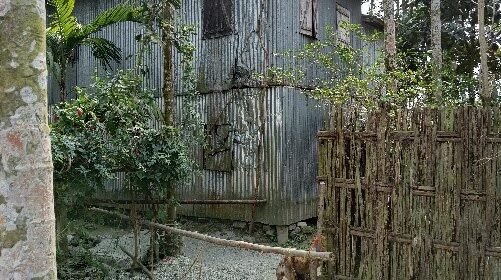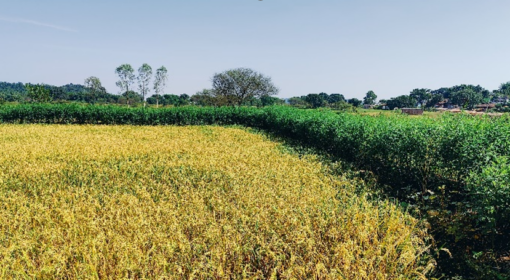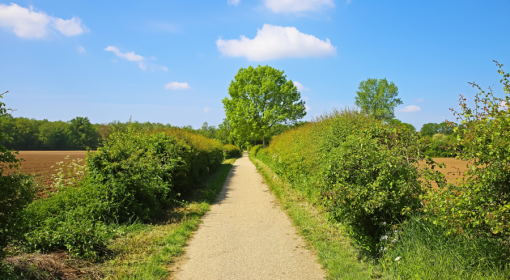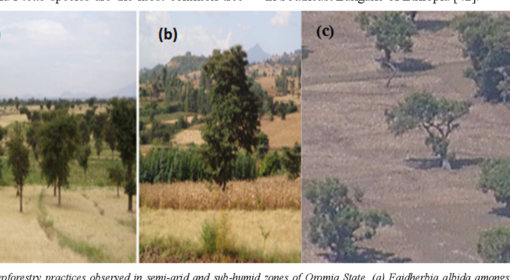By Femke van Woesik, Redeat Daneil, and Meghna Mukherjee
Hedges, integral to agricultural landscapes for centuries, were primarily planted as a boundary to prevent livestock or predators from entering farm fields and resource supply. Beyond these functions, hedges offer multifaceted advantages such as enhancing soil quality, moisture retention, erosion prevention, wind shelter, pest management, and biodiversity promotion. With low risks, hedges yield abundant benefits to farmers (Kumar et al., 2013).
Hedges, formed by a dense mix of shrubs and trees, host remarkable biodiversity. They provide habitats for diverse insect and animal species, encompassing birds, mammals, and insects. These living barriers provide shelter and establish vital connections between habitats, facilitating wildlife movement under their protective canopy. When linked to local forests and acting as corridors, the richness of plant and animal life flourishes further. Hedges additionally nurture numerous small creatures that are natural predators, regulating pest and rodent populations in their vicinity, extending up to 100 meters. Beneath the hedges, a diverse soil ecosystem thrives, contributing to rainworms, sow bugs, and more. Hence, hedges are called ‘biodiversity boosters,’ showcasing their multifaceted ecological importance. Furthermore, hedges supply food through leaves, flowers, berries, fruits, seeds, and nuts, becoming prime hunting grounds for predators. Simultaneously, they act as natural windbreaks, affording shelter and shade that prove advantageous for humans, livestock, and crops.
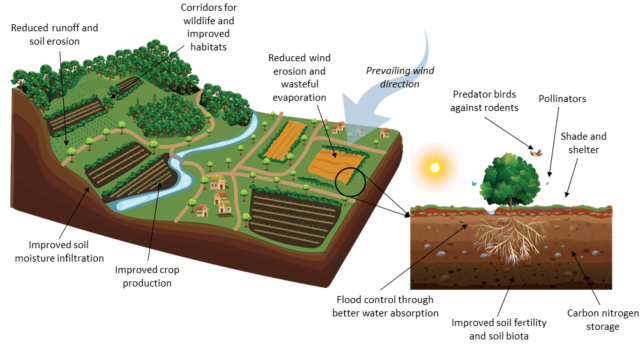
Hedges have traditionally been a prevalent sight in India’s rural regions, particularly within agricultural landscapes, serving as living fences and windbreaks. However, the status of hedges is shifting due to declining traditional agroforestry and land fragmentation practices. This leads to habitat fragmentation and reduced landscape connectivity (Précigout & Robert, 2022). On the positive side, India is actively pursuing the restoration and promotion of hedges through ecological restoration initiatives.
Suitable hedgerow species
Two species groups are employed in live fencing and hedging: (1) species primarily for protection: fence species, and (2) species yielding fruit, fuel wood, and fodder. Hedgerows often comprise multiple species. When selecting hedgerow species, the factors outlined by Kumar et al. (2013) should be taken into consideration:
- Easy management and protection
- Adaptability to local agroclimatic conditions
- Fast growth
- Coppicing ability (capacity of species to put out new shoots from their stumps or roots if cut down)
- Multiple uses in line with wishes of the farmer
- Ability to improve the soil and fix atmospheric nitrogen
- Nutritious or medicinal value
According to Kumar et al. (2013), in any area it would be desirable to investigate the trees that are already being used as living fences. Some promising hedgerow species are listed in the table below.
| Species | Description |
| Carissa Carandas | Carissa Carandas, a 2 to 4-meter-tall evergreen, deciduous shrub, is favored for fencing hedges due to its dense foliage and spiny branches. The thorny stems offer effective cattle protection and act as robust windbreaks. Once established, it thrives with minimal intervention, displaying drought tolerance. The plant’s hardiness allows it to flourish mostly rainfed (Bhowmick, 2023). Furthermore, Carissa Carandas maintains a cool microclimate under its canopy, aided by moisture retention from the mulch at its base (Lohar, n.d.). |
| Lawsonia inermis (Mehendi) | Mehendi, a robustly growing shrub reaching 2 to 6 meters, forms dense hedges and is commonly planted alongside mulberry, cacti, or jatropha. Lawsonia inermis grows well in dry and moist places but needs irrigation if planted in dry or silty soils. With low maintenance demands, it exhibits strong resilience to varying soil moisture levels (Lohar, n.d.). The leaf powder, known as henna, finds use as a skin and hair dye (Kumar et al., 2013). |
| Jatropha curcas | Jatropha curcas, an evergreen perennial shrub up to 4 meters tall, offers multiple benefits. It serves as a living fence to deter livestock due to its unpalatability to goats and cattle. It can be pruned and looped or weaved into desired heights to suit the purpose of the living fence (Lohar, n.d.). It is a strong species with low maintenance requirements and can grow in almost any type of soils. |
| Agave americana | Agave americana is remarkably drought tolerant, thriving in well-drained, slightly acidic, sandy, or gravelly soils (Kumar et al., 2013). This adaptability extends to arid and degraded environments. Additionally, Agave is to some extent fire resistance, rendering it suitable for farm perimeters in fire-prone regions (Lohar, n.d.). |
| Caesalpinia Bonducella (Sagargota) | Sagargota, a thorny shrub, reaches 6 meters in height, thriving in drought conditions and various soil pH levels. It easily propagates from seeds. Its spiky branches and fruits create dense zones, deterring animal and rodent movement. The flowers also draw beneficial insects and pollinators (Lohar, n.d.). |
To enhance fence volume, additional climbing and crawling plants like Jasmine, Butterfly pea, Malabar spinach, Passionflower, Passion fruits, Red lagoon creeper, an array of beans, and more can be cultivated in unison (Lohar, n.d.).
Developing hedgerows in a landscape
One approach to establish a living fence involves planting hedging species in rows and attach wire between them. Insert large cuttings or stakes, around 2.5 meters in length (with 20-40 cm in the ground), where regular fence posts would go. These cuttings will sprout and grow, ideally established prior to attaching fence wire. If some die, they should be replaced. In regions with uncertain rainfall, aiding post growth by filling post holes with quality soil and maintaining moisture could be beneficial.
In situations involving grazing or browsing animals, initiating live fence posts and eventually a living fence necessitates starting with a non-living fence posts, such as bamboo poles. Gradually, these are replaced with live fence posts.
A sustainable approach to integrating hedges into agricultural landscapes to create a win-win solution for farmers and the environment should be developed and executed.
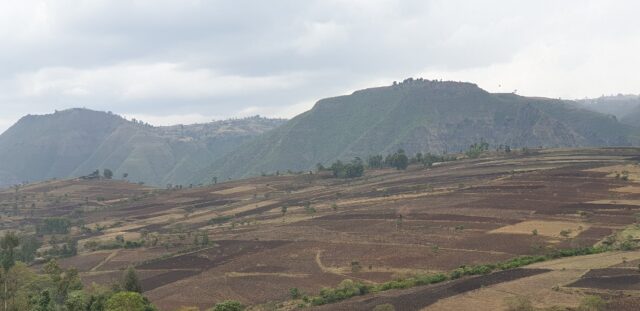
References
Précigout, P. A., & Robert, C. (2022). Effects of hedgerows on the preservation of spontaneous biodiversity and the promotion of biotic regulation services in agriculture: towards a more constructive relationships between agriculture and biodiversity. Botany Letters, 169(2), 176-204.
Verma, Y., Rawat, H., Parveen, R., Saini, N., Negi, N., Mishra, A., … & Gaurav, N. (2021). Potentials and cultivation of bubble bush (Jatropha curcas Linn.) in human welfare: A review. Int. J. Bot. Stud, 6, 367-376.
Bhowmick, N., Sharma, K. M., & Parameshwar, P. (2023). Carissa carandas L. In Himalayan Fruits and Berries (pp. 47-61). Academic Press.
Lohar, S. (n.d.). Living fence plants from India – permaculture plants. Permaculture Plants. https://permacultureplants.com/live-fence-plants-india/
Kumar, S., Naugraiya, M., & Patil, G. (2013). Review Environmental benefits of Live Fence and their role in biodioversity conservation. LIFE SCIENCES LEAFLETS, 37, 6-to.
